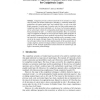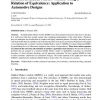1507 search results - page 60 / 302 » Separating Complexity Classes Using Structural Properties |
FOSSACS
2008
Springer
13 years 11 months ago
2008
Springer
Coalgebras provide a uniform framework for the semantics of a large class of (mostly non-normal) modal logics, including e.g. monotone modal logic, probabilistic and graded modal l...
DATAMINE
2006
13 years 10 months ago
2006
Standard hidden Markov models (HMM's) have been studied extensively in the last two decades. It is well known that these models assume state conditional independence of the ob...
HYBRID
1998
Springer
14 years 2 months ago
1998
Springer
We discuss properties of high order neurons in competitive learning. In such neurons, geometric shapes replace the role of classic `point' neurons in neural networks. Complex ...
DSN
2002
IEEE
14 years 2 months ago
2002
IEEE
Model checking has been introduced as an automated technique to verify whether functional properties, expressed in a formal logic like computational tree logic (CTL), do hold in a...
BMCBI
2010
13 years 10 months ago
2010
Background: Genetic interaction profiles are highly informative and helpful for understanding the functional linkages between genes, and therefore have been extensively exploited ...


